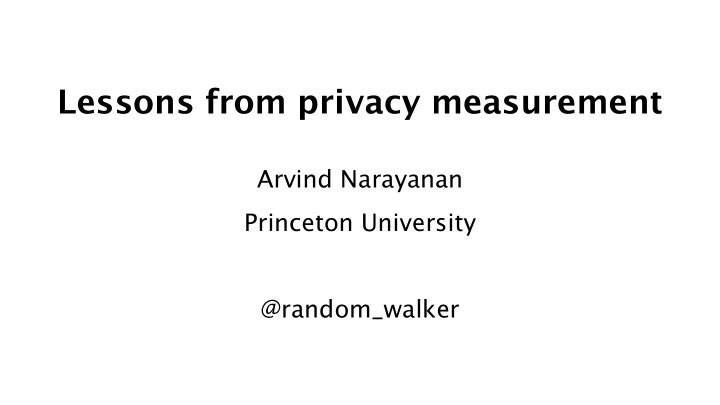



Lessons from privacy measurement Arvind Narayanan Princeton University @random_walker
Caveat: my work is in the web privacy space BUT I’ve aimed to extract broadly applicable lessons
Common theme: issues beyond encryption
Outline of this talk • The ship has not sailed • Privacy attitudes and technologies evolve rapidly; how can standards cope? • Measurement: why it matters and how to preserve it
Panopticlick (2009) Over 90% of users had a unique browser fingerprint Fingerprinting is a privacy violation Cannot be seen/controlled by user
AmIUnique (INRIA, France): similar conclusions
Partial list of fingerprinting vectors • User agent • Screen resolution/depth • Accept header • List of fonts • Content encoding • List of HTTP headers • Content language • Platform • List of plugins • Do Not Track • Cookies enabled? • Canvas • Local/session storage? • WebGL • Timezone • Use of ad blocker
Conclusion: the horse has left the barn Fingerprinting is devastatingly effective Too late for anti-fingerprinting (Me, until a year ago)
But wait… users in previous studies self selected New study: • Only a third of users unique • Mobile users: less than a fifth • Number going down as Flash and Java phased out Gómez-Boix et al. : Hiding in the Crowd: an Analysis of the Effectiveness of Browser Fingerprinting at Large Scale. WWW 2018.
Avoid privacy defeatism The ship has not sailed Imperfect defenses are still useful Technology doesn’t have to bear the full burden
Outline of this talk • The ship has not sailed • Privacy attitudes and technologies evolve rapidly; how can standards cope? • Measurement: why it matters and how to preserve it
Privacy attitudes evolve quickly Example: individual vs collective harms Example: tradeoffs between privacy and other values Result: Fixed technical definitions have difficulty capturing evolving norms and attitudes
Predicting sensitive traits from public FB “Likes” Predicting “big 5” personality traits based on regression analysis of FB likes Allegedly used by Cambridge Analytica for psychographic targeting Kosinski et al : Private traits and attributes are predictable from digital records of human behavior. PNAS 2013.
Privacy-infringing technologies evolve quickly Paul Ohm’s “database of ruin”: a single, massive database containing secrets about every individual, formed by linking different companies’ data stores
Proposal: a tighter feedback loop Incentivize academic researchers to Standards – Do privacy reviews of standards – Study API use in the wild Be explicit about assumptions – Intended and unintended uses Researchers Developers – “Defense in depth” in case of misuse Olejnik et al. : Battery Status Not Included: Assessing Privacy in Web Standards. IWPE 2017.
Outline of this talk • The ship has not sailed • Privacy attitudes and technologies evolve rapidly; how can standards cope? • Measurement: why it matters and how to preserve it
Measurement and privacy Claim: measurement research has played a key role in keeping web privacy abuses in check
A tool for finding privacy violations
Impacts of web privacy measurement • Enhancing blocklists • Informing the public • Correcting information asymmetry • Convincing browser vendors to act • Enforcement action in most egregious cases • Informing policy makers
What about IoT? 👎 Most devices are end-to-end encrypted 👏 The two ends are the device and the server, not the user (or researcher) ⇒ Meaningful privacy measurement infeasible
If our smart lightbulbs are transmitting conversations from our homes, do we have a way to know?
Proposal: a debug mode for IoT devices or researcher When enabled, device allows user to intercept plaintext Details and UX will depend on device No technical way to prevent cheating; reputational and legal incentives instead
Summary of this talk • The ship has not sailed • Privacy attitudes and technologies evolve rapidly; how can standards cope? • Measurement: why it matters and how to preserve it
Recommend
More recommend